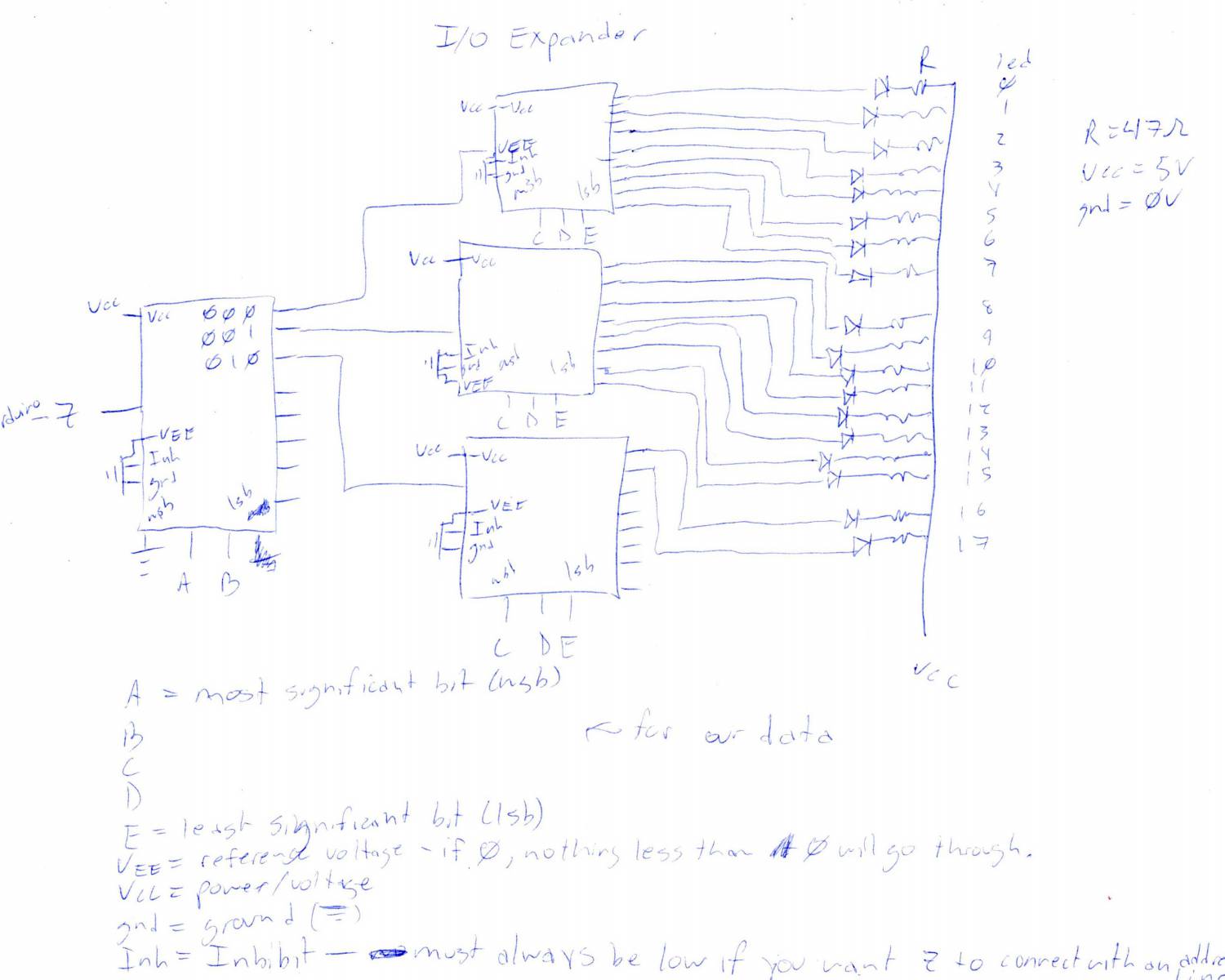This is only an example/test code that I used to see if the i/o expander would still work with the light sensors (which it did). If anyone needs to make up their own, they may remove all sub-functions and whatever is in the loop function to get it to work. All you have to do to go to a certain address of the i/o expander is to digitalWrite Apin through Epin to the values of A through E. (see the beginning of the reads sub-function).
For this i/o expander, we used 4 4051's–three were attached to the first three address lines of the first.
Here is the datasheet
*Look at the bottom of the page for an update to the convert subfunction.
//This is i/o expander has 18 possible outputs--possible 32 if convert is edited
//it's loop will only go through the lowest 6 addresses and will read the light sensor at each, one at a time
int reads(int led);//read led
int readsavg(int n, int led);//takes average of n readings for led
int convert(int i);
int anodePin=4;//all led's use this pin for their long leg
int Apin=14;//A0
int Bpin=15;//A1
int Cpin=16;//A2
int Dpin=17;//A3
int Epin=18;//A4
int cathodePin0=19;//A5
int A;
int B;
int C;
int D;
int E;
void setup(){
_SFR_IO8(0x35) |= 4;
_SFR_IO8(0x35) |= (1<<4);
pinMode(anodePin, OUTPUT); //set pins associated with led light sensors to outputs
pinMode(Apin, OUTPUT);
pinMode(Bpin, OUTPUT);
pinMode(Cpin, OUTPUT);
pinMode(Dpin, OUTPUT);
pinMode(Epin, OUTPUT);
pinMode(cathodePin0, OUTPUT);
digitalWrite(anodePin, HIGH);
digitalWrite(cathodePin0,LOW);
digitalWrite(Apin,LOW);
digitalWrite(Bpin,LOW);
digitalWrite(Cpin,LOW);
digitalWrite(Dpin,LOW);
digitalWrite(Epin,LOW);
Serial.begin(9600);
}
void loop(){
int n=3;
for(int j=0; j<6; j++){
int i=readsavg(n,j);
Serial.print("j is");
Serial.println(j);
Serial.print("i is");
Serial.println(i);
delay(1000);
}
}
int reads(int led){
led=led;
int val = 0;
int vcc=anodePin;
convert(led);//get address of led
//set multiplexer's to read that address
digitalWrite(Apin, A);
digitalWrite(Bpin, B);
digitalWrite(Cpin, C);
digitalWrite(Dpin, D);
digitalWrite(Epin, E);
digitalWrite(vcc, HIGH);
digitalWrite(cathodePin0, LOW);
/* Serial.print(A);
Serial.print(B);
Serial.print(C);
Serial.print(D);
Serial.println(E);*/
//already emitting light
delay(50);
//switch potentials -- charge LED to -5V
digitalWrite(vcc, LOW);
digitalWrite(cathodePin0, HIGH);
//measure time for potential to equalize (for cathode to be LOW)
//switch pinmode
pinMode(cathodePin0, INPUT);
//measure time it takes for cathodePin to go to zero
//this value probably depends on the chip clock or something
while((digitalRead(cathodePin0) != 0)&&(val<100)){
delay(1);
val++;
}
pinMode(cathodePin0, OUTPUT);
digitalWrite(vcc, HIGH);
digitalWrite(cathodePin0, LOW);
//Serial.println(val, DEC);
return val;
}
int readsavg(int n, int led){
int val=0;
for(int i=0; i<n; i++){
val=val+reads(led);//read n times and sum
}
val=val/n;//divide by n for average
return val;
}
int convert(int i){
//converts a decimal number from 0 to 17, inclusively, to binary
A=i/16;
if(A==1){
i=i-16;
B=0;
C=0;
D=0;
E=i;
}
if(A==0){
B=i/8;
if(B==1){
i=i-8;
C=i/4;
if(C==1){
i=i-4;
D=i/2;
if(D==1){
i=i-2;
E=i;
}
if(D==0){
E=i;
}
}
if(C==0){
D=i/2;
if(D==1){
i=i-2;
E=i;
}
if(D==0){
E=i;
}
}
}
if(B==0){
C=i/4;
if(C==1){
i=i-4;
D=i/2;
if(D==1){
i=i-2;
E=i;
}
if(D==0){
E=i;
}
}
if(C==0){
D=i/2;
if(D==1){
i=i-2;
E=i;
}
if(D==0){
E=i;
}
}
}
}
}
**This is an update to the convert subfunction: I realized that the above chain of if statements was stupid and that there is a much better way to do it if you just put a bit more thought into it. So here it is:
void convert(int i){
//This function handles numbers from 0 to 31
A=i/16;
i=i-(A*16);
B=i/8;
i=i-(B*8);
C=i/4;
i=i-(C*4);
D=i/2;
i=(D*2);
E=i;
}
//so much nicer right
Here is the promised circuits diagram:
